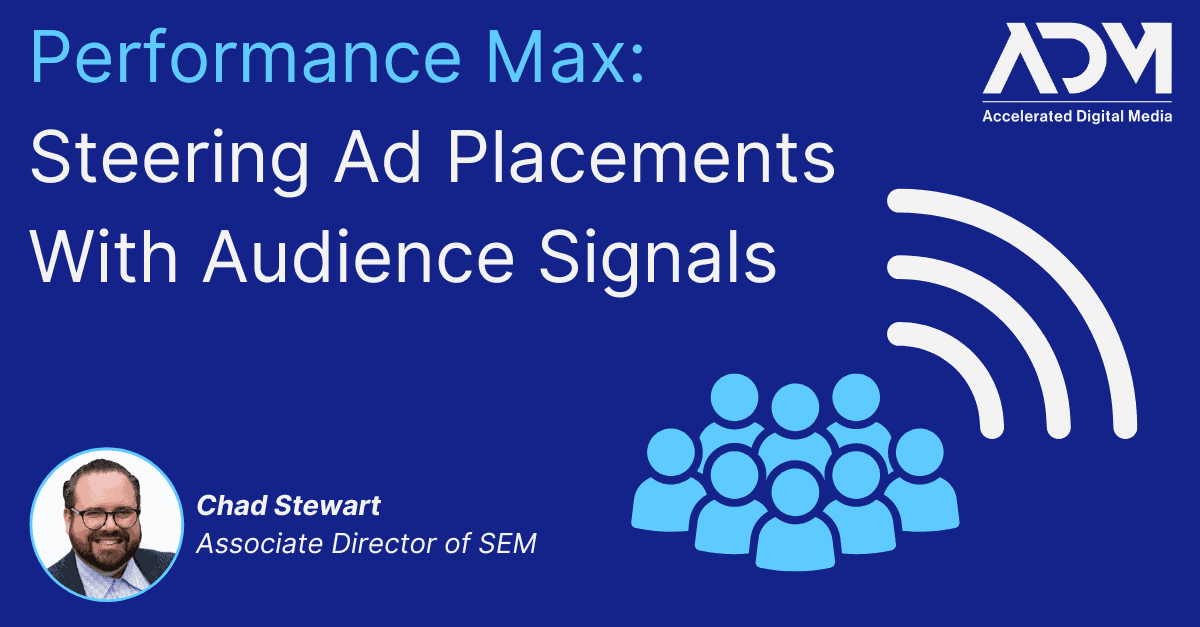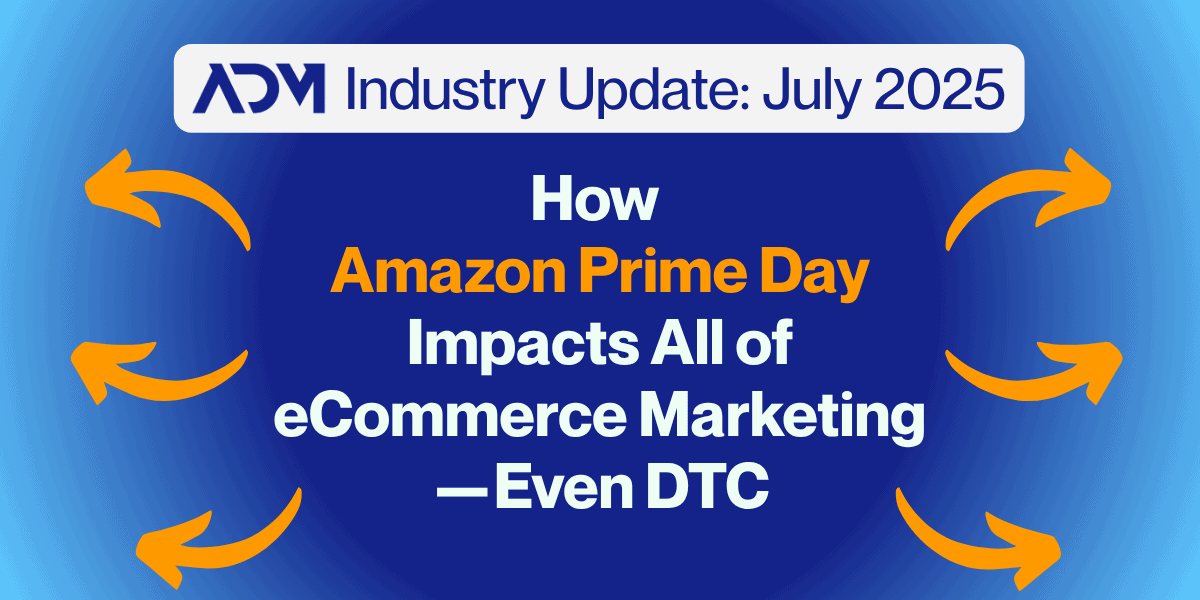If you’ve spent any time deploying or reading about digital marketing at all over the last two years, you’ll know that Performance Max campaigns are now a dominant force in Google Ads. That’s why we’ve devoted so many words to exploring and explaining how to get more out of these campaigns.
Because they are an AI-driven campaign type, one of the major complications with Performance Max is that they limit advertiser control in ways that regular Search campaigns do not. But that doesn’t mean you have to leave your ad targeting entirely up to the algorithm. Enter Audience Signals, the best lever you can pull to direct your Performance Max campaigns in the right direction.
This blog is part of our series of guidances about using Performance Max to its fullest potential. We’ve already laid out tips for bids and budgeting, ideas for how to segment campaigns, and best practices for feed optimization. In this blog, we’ll break down what Audience Signals are, the different types of them, and ways to use them.
What Are Audience Signals?
Audience Signals are a Performance Max feature that allows advertisers to create dynamic groups of users for Google’s AI to optimize its campaign targeting from. Theoretically, Audience Signals can be seen as a “starting point” from which the algorithm can learn to best understand what type of users will be most likely to convert.
It’s important to note that Audience Signals are tied to asset groups, allowing advertisers to be hyper-specific about the alignment between audiences and assets. Google’s AI learns who is most likely to convert based only on the assets assigned to that Signal, rather than attempting a one-size-fits-all approach across your Google Ads account.
For Performance Max campaigns, Audience Signals aren’t required, but it makes little sense not to use this feature. It’s also important to note that Audience Signals are not the same as Audience targeting. Regular Audience targeting, which isn’t available in Performance Max, shows ads exclusively to a specified audience. Instead, Audience Signals act more as “guidelines” to point the algorithm in the right direction.
Types of Performance Max Audience Signals
Audience Signals can be deployed in a three different formats, as follows:
Custom Intent
As the name suggests, these are audiences based on user search behaviors. When creating a custom intent Audience, an advertiser uploads a list of keywords or themes and Google creates an audience of users who have searched for those terms. There is a chance Custom Intent will go away, however—the newly-introduced Search Themes feature seems like an early step towards Google phasing these out.
First Party Data
This is the data that an advertiser is able to provide, generally Remarketing or Retention.
When we say Remarketing, we’re referring to users who have been to your site but have not yet converted. These lists can be segmented by more specific actions than just website visits, however. They’re highly-customizable: You can base them off things like cart abandoners, email subscribers who haven’t converted, or users who have viewed X number of products in the last 30 days without making a purchase.
When we say Retention, we’re talking about re-engaging users who have converted previously. At ADM, we often use Retention audiences as follows: First, we might create GA4 audiences based on what products users have actually bought. This allows us to use specific Purchaser audiences, such as “Men’s Button Up Buyers”, as an Audience Signal within closely targeted asset groups like “Men’s Button Ups.” The same principles could apply to Audience Signals based on purchases of a certain value (“purchases between $250 and $500” vs “purchases over $1,000”).
Google’s Default Audiences
These are the standard “In-Market” and “Affinity” audiences (as well as demographics) that you know and may or may not love from other Google Ads campaign types. While you can get audience-level insights into how different these audiences interact with your site when paired with other campaign types (like Demand Gen), these are generally the least reliable and impactful audiences in our experience.
Tips for Using Audience Signals
Since Audience Signals are assigned at the asset group level, they can help push your campaigns to place the right ads in front of the right people, giving you back a bit of control over who sees them.
Your Audience Signals Should Reflect Your Segmentation
For instance, if an apparel brand has a “Shorts” campaign, it might break the campaign into “Men’s Shorts” vs “Women’s Shorts” in separate asset groups, and in addition to Audience Signals, you might assign separate demographics (gender) to each asset group as well.
Continually Optimize First Party Audience Signals
If you’re using first party data Audience Signals, it’s important to perform regular hygiene to ensure your data stays relevant. Most data types will be dynamic, and therefore will refresh on their own. But if you upload a static customer list, we’d recommend refreshing it about every 90 days or so to ensure you’re not serving ads to those no longer interested in your products.
Eliminate Audience Signal Overlap in Asset Groups
While you can use the same Audience Signals in multiple asset groups, our recommendation is to ensure that each asset group’s signals are as unique as possible. While you might include the same high-level in-market audience for every asset group, you want to make sure there are still some other differentiators—such as Custom Intent lists—that can help Google more closely identify which users are most relevant for which asset groups.
Prioritize Custom Intent Signals
Because custom intent audiences are based on specific user behaviors, these signals can be especially effective in highlighting the right users for Google to target. Customer lists and other first-party data lists can also be extremely useful, but custom intent audiences are dynamic, so they’re always current. Depending on how other first-party lists are uploaded or configured, they may become outdated in time.
Use Audience Signals of All Types
ADM’s recommendation is to use all possible types of Audience Signals, because the more data you can provide to Google about who should see your ads, the more effectively Google’s AI will find those users. The more intricately you design and deploy your Audience Signals, the less likely your competitors are to have the exact same configurations within their campaigns.
Why Audience Signals Matter
Simply put, you want to take advantage of anything that can help steer your Performance Max campaigns towards the audiences who will help you achieve your advertising goals. Audience Signals will do that—even if Performance Max targeting remains something of a black box in terms of performance/impact, Google generally rewards advertisers who follow “best practices” like using Audience Signals. If nothing else, this will likely help get your ads into more auctions.
If you want to gain a deeper understanding of how to develop and deploy your Performance Max campaigns, be sure to check out our other guidance blogs on the topic. And if you have questions about how to get the most out of powerful, AI-driven digital marketing tools, reach out to the ADM team today.




